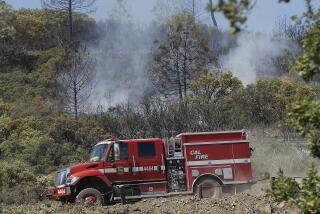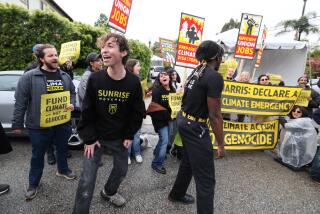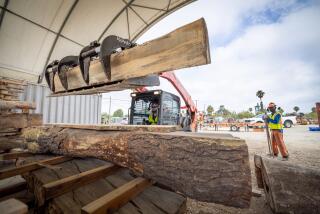FDR’s Idea Engendered Work Ethic
Harvey Herrington will never forget his three years of labor in the Civilian Conservation Corps.
Herrington fought brush and forest fires at Keene Camp near Tehachapi. He drove a truck in a Death Valley camp, where temperatures might top 120 degrees during the day and never drop below 100 at night. And he spent a winter building roads and trails in the Sequoia National Forest.
“Hard physical work never hurt anybody,” the 82-year-old Ojai resident said of his stint in the corps six decades ago.
Herrington and 77-year-old John Nichols Sr. of Ventura were two of nearly 3 million young men who, from 1933 to 1942, made up the CCC, living in camps and working on projects that improved the nation’s infrastructure, forests and historical sites.
Now Herrington is helping to motivate a new generation of workers. Once a month, he meets with the California Conservation Corps, a 1980s spinoff of the CCC, and presents young adults with wristwatches for outstanding service.
“I give the kids encouragement and talk about things they should and should not do,” Herrington said. “I tell them to pay attention to their supervisors.”
In 1933, when the Depression had stripped workers of employment and homes of food, President Franklin D. Roosevelt instituted the Civilian Conservation Corps with the goal of “putting America back to work.”
Young men between the ages of 17 and 25 were eligible for the program, which provided food, shelter and monthly pay of $30. The men, in what was dubbed the Forest Army, kept $5, and $25 was sent to their families.
“The thing that surprises people most is the impact that the CCC made,” said Cindy Smith, curator of Conservation Corps State Museum in San Luis Obispo. “At one point, one of every 20 young men had been in the CCC.”
Some people who are just learning about the camps have a misconception that the participants were derelicts, she said. “In the beginning of the program, you had to be on some kind of relief before you could be enrolled. But that did change. There were kids from all walks of life.”
For Nichols, the responsibilities of adulthood started early.
When the Ventura retiree was 13, he already had a job in an outdoor produce market, where he worked for two hours before school and five hours after.
“My mom raised four kids by herself,” Nichols said. “I helped to supplement the family income.” By the time he was 14, he had installed a telephone in the family home and purchased a used car for $15.
And at the age of 17, he enrolled in the CCC.
On his first day at La Purisima Mission camp in Lompoc, Nichols said, the men in the barracks stole everything of value that he owned.
“But within a week, I became one of the guys, and they gave it all back to me,” said Nichols, a retired truck driver and former manager of a milk business.
“I am driven to work,” he said. “I was raised [believing] that the only way you were going to get something was to work for it.” For six months, he cut logs, competing with the other men to be the fastest and the best.
In the program--whose motto was “We Can Take It”--nearly 33,600 California men planted trees, refurbished historic sites and built roads, trails and wildlife shelters. The CCC also fought forest fires, stocked almost a billion fish and pared more than 4 million acres of trees in the United States.
In Ventura County, men worked in 21 camps, where they built recreation areas including Steckel Park near Santa Paula, Wheeler Springs in Ojai and Foster Park in Ventura.
All the hard work and ample food revitalized many young men who had been undernourished during the Depression.
Herrington was 6 feet 3 and weighed 128 pounds when he entered the corps. But within a month, he wrote a letter to his mother saying that there was enough food for him to eat three pork chops for dinner, and his weight had shot up to 156.
“The hard work built up my muscles,” Herrington said. “When you do hard work and get used to it you sleep better at night and don’t feel like carousing around.”
Work days started at 7:30 a.m., lunches were finished in 30 minutes, and after the labor stopped at 4 p.m., men dressed for a bugle call to assemble at 5 p.m. During the evenings, the men were on their own, albeit under the supervision of the U.S. Army. Many of the workers who had not completed high school took advantage of night classes in math, reading and writing that were offered at the camps.
“The best thing about the camp was that it kept me out of jail,” Nichols said. “You learned to get along with other people.”
For Herrington, that was tough.
“I was pretty aggressive when I was young,” he said. “If I didn’t like somebody, I’d hit him.”
But the corps had advancement opportunities for those with leadership skills.
“I ended up as assistant leader at the camp and got $5 extra [each month] for the last six months that I was in,” said Herrington, a retired Caltrans highway supervisor. “It sure made a man out of me and everyone else that was in the CCC. It taught me to be myself and not to be pushy.
“I never finished high school, but I learned all my trades from the CCC,” added Herrington, one of the founders of the Conservation Corps State Museum. “Skills that I learned went from running a jackhammer to driving a truck and learning plumbing and electrical work.”
In initiating the corps, Roosevelt knew the benefits would include more than better forests. In an address to Congress, he cited the “moral and spiritual value of such work.”
Herrington, who was raised a Quaker, “always had the feeling that God put everything in nature on earth and we should take care of it. The spiritual part for me was to go out and see how beautiful the trees looked after they were planted. It gave you pride. It made you happy that you could get along with your neighbor.”
Looking back, Nichols said that many of his work attitudes may have developed from his experience at the CCC camps.
“I worked for 25 years and had only two or three sick days,” he said. “I thought my job was number one, even more important than my family.”
The corps disbanded in 1942, and many of the men who were once members of the Forest Army went into the U.S. Army to fight in World War II.
Although many baby-boomers have heard their fathers’ stories about the CCC camps, the anecdotes are sometimes met with a shrug, said Smith, the curator. But recently, more people have shown a renewed interest in the corps.
“These men are marching into history,” Smith said. “Therefore, people are becoming more aware of it as a historical thing that happened to our country and for the good of our country.”
More to Read
Sign up for Essential California
The most important California stories and recommendations in your inbox every morning.
You may occasionally receive promotional content from the Los Angeles Times.










